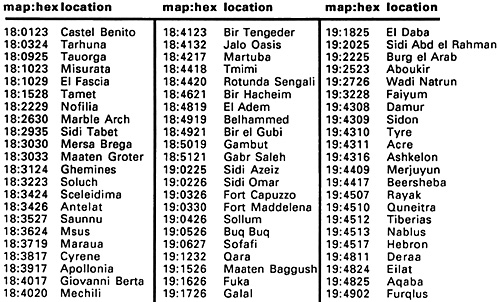Part I
When I first viewed my mapsheets of War in the Desert several years ago, I was somewhat disappointed. Somehow it was missing some of the atmosphere of "the Blue." True, there are wadis, and in the south the sands of the Qatarra and Kalansho sand seas wash against the playing area, but other than that the Libyan Desert bears a distinct resemblance to Ukrainian farmland.
The prime contributor to this is the lack of named locations on the maps. Where are the familiar placenames made famous by the desert's literature: Mechili, Bir Hacheim, Fort Capuzzo, Sidi Omar, Mersa Brega? After a couple of games, I could stand it no longer. Out came a pen and in went point cities across the desert. Undoubtedly these will be officially placed in the next edition of Western Desert, by which time point cities will be common across Europe. Until then, I will make do with my ersatz placements given below.
The term "point cities" stretches the definition of city when applied in the desert. Most of the locations in the desert are hardly deserving of the name. Many were old Turkish or Italian beaugeste style forts - Mechili for instance. Birs were cisterns, sometimes dating from Roman times, often long disappeared, with their former locations marked merely by a pile of stones. The word sidi means "tomb" in Arabic, and Sidi Rezegh, the site of the climax of "Operation Crusader" was just that and nothing more - a small stone tomb visible as a landmark and near an airfield.
It is easy to dismiss these places as undeserving of a place on an Europa map, but you should realize that some of the reference cities already shown on the maps are not much better. If you see a period airborne photograph of Bardia or Tobruk, the word .. city" hardly jumps to the tongue. Consider Alan Moorehead's description from Road to Tunis of Sidi Barrani shortly after it wasrecaptured during "Operation Compass" (the tramway he refers to was mentioned in previous Italian radio broadcasts).
"in actual fact, Sidi Barrani's twenty meager houses had never required a tramway and certainly never had one, and the only shop I saw there was the village store with a bomb through the middle of it. Nevertheless there did exist one or two substantial white stone buildings on the seafront."
One caution: the most difficult part of physically printing the place names on the maps is writing perfectly level and horizontal. If you have difficulty with this, try putting a very lightweight pencil line with a ruler or other straightedge to use as a lettering guide before you print the name.
Adding the following locations on maps 18 and 19 will add a lot of flavor to your "War in the Desert" campaigns.

Back to Europa Number 13 Table of Contents
Back to Europa List of Issues
Back to MagWeb Master Magazine List
© Copyright 1990 by GR/D
This article appears in MagWeb (Magazine Web) on the Internet World Wide Web. Other military history articles and gaming articles are available at http://www.magweb.com